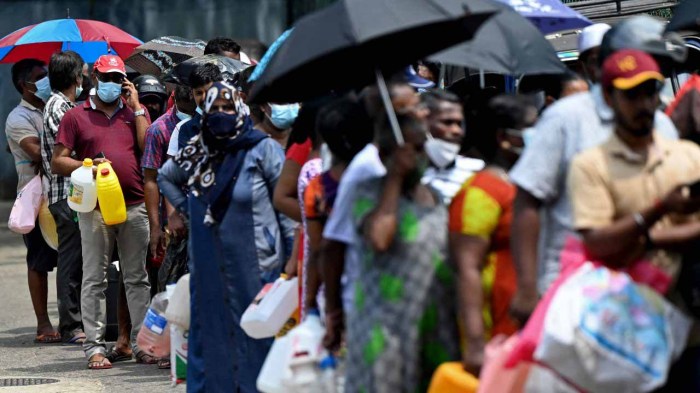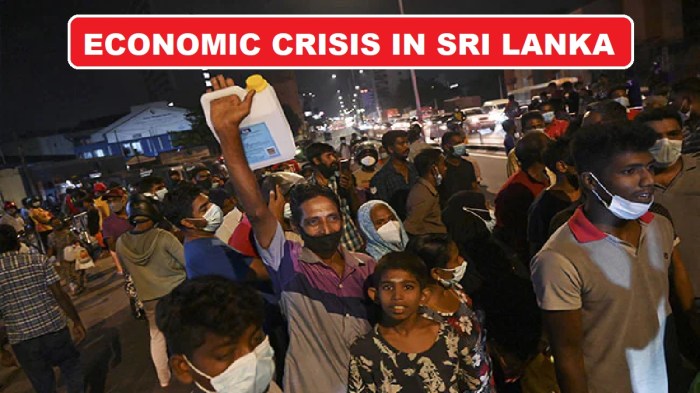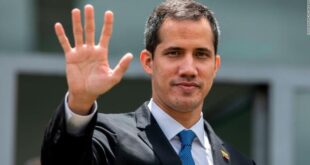Heavily indebted Sri Lanka votes in election to decide economic future. This island nation faces a dire economic crisis, a culmination of years of mismanagement, exacerbated by the COVID-19 pandemic. The recent presidential election, held in the midst of widespread hardship, saw citizens casting their ballots for a leader who can steer the country towards a path of economic recovery.
From soaring inflation and currency devaluation to shortages of essential goods, Sri Lanka’s economic woes have deeply impacted the lives of its people. The election presented a critical juncture for the nation, offering a chance to elect a government capable of addressing these challenges and rebuilding the economy.
Sri Lanka’s Economic Crisis

Sri Lanka’s economic crisis, a culmination of years of mismanagement and exacerbated by the COVID-19 pandemic, has plunged the nation into a state of unprecedented hardship. The crisis has manifested in soaring inflation, a plummeting currency, and widespread shortages of essential goods.
This has led to widespread public unrest and political turmoil, forcing the country to seek international assistance to navigate its way out of the economic abyss.
Contributing Factors to the Crisis
Sri Lanka’s economic crisis can be attributed to a confluence of factors, including:
- Excessive Borrowing:Sri Lanka has a long history of borrowing heavily from foreign creditors, primarily China, to fund infrastructure projects. This resulted in a massive debt burden, which became increasingly unsustainable as interest payments grew.
- COVID-19 Pandemic:The pandemic dealt a severe blow to Sri Lanka’s tourism sector, a major source of foreign currency. This, coupled with global supply chain disruptions, further aggravated the country’s economic woes.
- Policy Decisions:A series of ill-advised policy decisions, such as tax cuts and the ban on chemical fertilizers, further weakened the economy. These decisions resulted in a decline in government revenue and agricultural output.
- Corruption and Mismanagement:Allegations of corruption and mismanagement within the government have also contributed to the crisis. These factors have eroded public trust and undermined the country’s economic stability.
Economic Indicators of the Crisis
The severity of Sri Lanka’s economic crisis is evident in several key economic indicators:
- Inflation:Inflation has skyrocketed in recent years, reaching a record high of over 60% in 2022. This has significantly eroded the purchasing power of Sri Lankan citizens, making it difficult for them to afford basic necessities.
- Currency Devaluation:The Sri Lankan rupee has depreciated sharply against the US dollar, losing over 80% of its value since 2015. This has made imports more expensive and fueled inflation.
- Unemployment Rate:The unemployment rate has risen significantly, particularly among young people and those in the tourism sector. This has exacerbated social tensions and increased poverty levels.
- Foreign Exchange Reserves:Sri Lanka’s foreign exchange reserves have dwindled to critically low levels, making it difficult for the country to import essential goods and services.
Impact on Daily Lives
The economic crisis has had a profound impact on the daily lives of Sri Lankan citizens:
- Shortages of Essential Goods:Sri Lanka has experienced widespread shortages of essential goods, including fuel, food, and medicine. Long queues at gas stations and supermarkets have become commonplace.
- Power Outages:Frequent power outages have disrupted businesses and daily life. The government has been forced to implement rolling blackouts due to the shortage of fuel for power generation.
- Healthcare:The healthcare system has been severely affected by the crisis. Hospitals are facing shortages of essential medicines and medical supplies.
- Social Unrest:The economic hardship has fueled social unrest and protests. People have taken to the streets to express their anger and frustration over the government’s handling of the crisis.
The 2022 Presidential Election
The 2022 Sri Lankan presidential election was held on November 16, 2022, amid a severe economic crisis that had plunged the nation into its worst financial turmoil in decades. The election was a crucial event, as it offered the Sri Lankan people a chance to choose their leader and determine the course of the country’s economic recovery.
Political Landscape
The political landscape in Sri Lanka leading up to the election was characterized by a deep sense of disillusionment with the ruling elite. The incumbent government, led by the Sri Lanka Podujana Peramuna (SLPP) party, had been widely criticized for its handling of the economic crisis, which had led to widespread shortages of essential goods, soaring inflation, and a dramatic decline in living standards.The main contenders in the election were:
- Gotabaya Rajapaksa, the incumbent president, was seeking re-election. He ran on a platform of national security and economic development, but his campaign was overshadowed by the economic crisis and the public’s perception that he had mishandled the situation.
- Sajith Premadasa, the leader of the Samagi Jana Balawegaya (SJB) party, was the main opposition candidate. He promised to address the economic crisis by promoting transparency and accountability in government, attracting foreign investment, and fostering economic growth.
- Anura Kumara Dissanayake, the leader of the Janatha Vimukthi Peramuna (JVP) party, campaigned on a socialist platform, promising to nationalize key industries and redistribute wealth.
Campaign Promises and Strategies, Heavily indebted Sri Lanka votes in election to decide economic future
The candidates employed a range of strategies to appeal to voters. Gotabaya Rajapaksa emphasized his record on national security, highlighting his role in ending the civil war in 2009. He also promised to continue his infrastructure development projects, such as the construction of highways and ports.Sajith Premadasa focused on the economic crisis, promising to alleviate the suffering of the people by providing essential goods and services at affordable prices.
He also pledged to restore Sri Lanka’s reputation as a reliable investment destination.Anura Kumara Dissanayake targeted voters who felt marginalized and excluded from the economic benefits of growth. He promised to implement a socialist economic model that would prioritize the needs of the working class.
Voter Turnout and Election Outcome
The voter turnout in the election was relatively high, indicating the public’s interest in the outcome. Gotabaya Rajapaksa won the election with a comfortable majority, securing over 52% of the vote. Sajith Premadasa came in second with around 40% of the vote, while Anura Kumara Dissanayake received less than 5%.The outcome of the election was a significant victory for Gotabaya Rajapaksa and the SLPP party.
It demonstrated that despite the economic crisis, voters were willing to give the incumbent president another term. Several factors contributed to Rajapaksa’s victory, including:
- His perceived strength on national security, which resonated with many voters who felt insecure in the aftermath of the civil war.
- The lack of a strong and united opposition, which allowed Rajapaksa to capitalize on divisions within the opposition ranks.
- The SLPP’s effective use of social media and other forms of communication to reach out to voters.
The 2022 presidential election was a pivotal moment in Sri Lanka’s political history. It marked a significant turning point in the country’s political landscape, with the incumbent president securing a second term despite the ongoing economic crisis. The outcome of the election will have a profound impact on Sri Lanka’s economic future, as the new government will face the challenge of addressing the crisis and restoring the country’s economic stability.
Economic Recovery and Future Outlook
Sri Lanka’s economic recovery hinges on the effectiveness of the newly elected government’s policies and strategies. The country faces a daunting task, requiring a comprehensive approach to address the crisis’s multifaceted challenges and lay the foundation for sustainable growth.
Economic Policies and Strategies
The new government has implemented a range of economic policies and strategies aimed at stabilizing the economy, restoring investor confidence, and promoting sustainable growth. These include:
- Fiscal Consolidation:Reducing the budget deficit through tax increases, expenditure cuts, and improved revenue collection. This aims to stabilize government finances and reduce debt burden.
- Monetary Policy Tightening:Increasing interest rates to curb inflation and stabilize the currency. This measure helps control the money supply and reduce inflationary pressures.
- Structural Reforms:Implementing reforms in key sectors like agriculture, tourism, and manufacturing to enhance productivity and competitiveness. This involves streamlining regulations, improving infrastructure, and promoting innovation.
- Debt Restructuring:Negotiating with creditors to restructure existing debt obligations, providing breathing room for Sri Lanka’s finances. This involves extending repayment terms, reducing interest rates, or seeking debt forgiveness.
- Foreign Investment Attraction:Encouraging foreign direct investment (FDI) by creating a conducive business environment and offering incentives. This aims to boost economic activity, create jobs, and transfer technology.
Challenges and Opportunities
Sri Lanka’s economic recovery faces significant challenges, but opportunities also exist for growth and development.
- External Factors:Global economic slowdown, rising commodity prices, and geopolitical instability pose external challenges. These factors can impact Sri Lanka’s export earnings, tourism revenue, and foreign investment.
- Domestic Constraints:High levels of public debt, weak governance, corruption, and limited access to finance remain domestic constraints. These factors hinder economic growth and development.
- Opportunities:Sri Lanka has potential for growth in sectors like tourism, agriculture, renewable energy, and IT. Leveraging these opportunities requires strategic investments, policy reforms, and a focus on innovation.
Long-Term Implications
The economic crisis has long-term implications for Sri Lanka’s economic future, including:
- Relationship with International Institutions:The crisis has strained Sri Lanka’s relationship with international institutions like the IMF and World Bank. Securing future assistance requires implementing structural reforms and demonstrating commitment to fiscal discipline.
- Foreign Investor Confidence:The crisis has eroded foreign investor confidence in Sri Lanka. Restoring trust requires transparency, accountability, and a predictable policy environment.
- Economic Vulnerability:The crisis has highlighted Sri Lanka’s vulnerability to external shocks. Diversifying the economy, reducing reliance on imports, and promoting domestic production can mitigate future risks.
International Response and Support
As Sri Lanka grappled with its unprecedented economic crisis, the international community stepped in with a mix of financial assistance, technical expertise, and policy guidance. The response was multifaceted, reflecting the complexity of the crisis and the interconnected nature of the global economy.
International Organizations’ Response
International organizations played a pivotal role in providing emergency relief, restructuring debt, and supporting Sri Lanka’s economic recovery.
- The International Monetary Fund (IMF)provided a $4 billion Extended Fund Facility (EFF)in March 2023, aimed at restoring macroeconomic stability, strengthening external buffers, and promoting sustainable growth. The EFF package included policy recommendations to address fiscal imbalances, strengthen debt sustainability, and improve governance.
- The World Bankoffered $700 million in budget supportto help Sri Lanka meet urgent needs and implement structural reforms. The World Bank also provided technical assistance to strengthen public financial management, improve governance, and promote sustainable development.
- The Asian Development Bank (ADB)pledged $2.5 billion in loans and grantsto support Sri Lanka’s economic recovery, focusing on infrastructure development, energy sector reforms, and social safety nets.
- The United Nations (UN), through its agencies, provided humanitarian assistance to address food insecurity, health needs, and other urgent humanitarian concerns.
Bilateral Support
Several countries extended financial and technical assistance to Sri Lanka, recognizing the urgent need for support.
- Indiawas a key bilateral partner, providing $4 billion in financial assistance, including a $1 billion line of creditfor essential imports. India also offered fuel, medicine, and other essential supplies.
- Chinaprovided $1.5 billion in financial assistanceand debt restructuring, reflecting its significant role in Sri Lanka’s infrastructure development.
- Japanoffered $1 billion in financial assistanceand technical support, focusing on infrastructure development, energy sector reforms, and capacity building.
- Other countries, including the United States, the European Union, and Australia, provided financial assistance and technical support to address specific needs, such as food security and social protection.
Effectiveness of International Efforts
International efforts have been instrumental in mitigating the immediate impact of the crisis and supporting Sri Lanka’s economic recovery. The IMF’s EFF program has provided much-needed financial support and policy guidance, helping to stabilize the economy and restore investor confidence.
The World Bank’s budget support has helped address urgent needs and implement structural reforms. India’s timely assistance, including fuel and essential supplies, has been crucial in alleviating immediate hardships. However, the effectiveness of these efforts depends on several factors, including the government’s commitment to implementing structural reforms, addressing corruption, and fostering a more conducive investment climate.
Public Sentiment and Social Impact
The economic crisis in Sri Lanka has had a profound impact on public sentiment and social life. The severe shortages of essential goods, coupled with soaring inflation, have led to widespread dissatisfaction and frustration among the population. This discontent has manifested in various forms, including large-scale protests, social unrest, and a decline in social cohesion.
Impact on Various Sectors of Society
The economic crisis has had a significant impact on various sectors of Sri Lankan society. The education system has been particularly affected, with schools forced to close due to fuel shortages and the inability to pay teachers’ salaries. The healthcare system has also been strained, with shortages of essential medicines and medical supplies.
The environmental impact of the crisis is also concerning. The government has resorted to unsustainable practices, such as burning garbage, to generate electricity, contributing to air pollution and exacerbating the environmental crisis.
Long-Term Consequences on Sri Lankan Society
The long-term consequences of the economic crisis on Sri Lankan society are likely to be significant. The erosion of trust in the government, coupled with the increasing levels of social unrest, could lead to political instability. The crisis has also exacerbated existing social inequalities, with the most vulnerable segments of society disproportionately affected.
Finish your research with information from The US is more hands-off than usual in the Middle East. It fears making things worse.
This could lead to further social fragmentation and a widening of the gap between the rich and the poor.
“The crisis has exposed the deep-seated vulnerabilities of Sri Lankan society and the need for urgent reforms to address these issues.”
[Name of expert]
Final Conclusion: Heavily Indebted Sri Lanka Votes In Election To Decide Economic Future

The outcome of the election will have far-reaching consequences for Sri Lanka’s economic future. The newly elected government faces a daunting task, navigating a complex web of challenges, including debt restructuring, attracting foreign investment, and fostering economic growth. The path to recovery will be long and arduous, requiring strong leadership, effective policies, and a united national effort.
Detailed FAQs
What are the main reasons behind Sri Lanka’s economic crisis?
The crisis is a result of several factors, including unsustainable debt levels, mismanagement of public finances, the impact of the COVID-19 pandemic, and a decline in tourism revenue.
Who were the main candidates in the recent presidential election?
The election featured a number of candidates, representing various political parties and ideologies. The final outcome will determine the direction of Sri Lanka’s economic recovery efforts.
What are the key challenges facing Sri Lanka’s economic recovery?
The country faces significant challenges, including a high debt burden, limited foreign reserves, and the need to rebuild trust with international investors.
What role will international support play in Sri Lanka’s recovery?
International organizations and countries will play a crucial role in providing financial assistance, technical support, and policy advice to help Sri Lanka overcome its economic crisis.
 CentralPoint Latest News
CentralPoint Latest News



